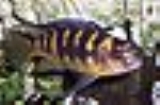
Pseudotropheus crabro
Encyclopedia
The bumblebee cichlid, Pseudotropheus crabro, is a freshwater
fish
of the cichlid family. It is also known as hornet cichlid. It is endemic to many regions of Lake Malawi
and is found in different habitats but most frequently in large caves. This species prefers a pH
range of 7.5–8.2 and a temperature range of 24–26°C
.
The bumblebee cichlid has an elongate body with vertical yellow-and-black "bumblebee" bars. Juveniles are brightly colored but become darker when mature, especially for males. This fish is known for its ability to rapidly change its colors. They can grow up to 10 cm. They are mouthbrooders like many other cichlids from Lake Malawi
.
In their natural habitats, the bumblebee cichlid is a cleaner
specialized in feeding on parasites
from larger fish particularly the catfish Bagrus meridionalis, which apparently recognises the species as a cleaner. Notable is that P. crabro has also been found preying upon the eggs of the bagrus catfish, but will change colour to a dark brown while doing so.
cichilds, this is a hardy and very aggressive fish that should be kept in a species or mbuna tank. The best practice is to keep one male with several females. Breeding is relatively easy. Females hold eggs and fry in their mouths for up to three weeks, then release a small number of healthy fry.
Freshwater
Fresh water is naturally occurring water on the Earth's surface in ice sheets, ice caps, glaciers, bogs, ponds, lakes, rivers and streams, and underground as groundwater in aquifers and underground streams. Fresh water is generally characterized by having low concentrations of dissolved salts and...
fish
Fish
Fish are a paraphyletic group of organisms that consist of all gill-bearing aquatic vertebrate animals that lack limbs with digits. Included in this definition are the living hagfish, lampreys, and cartilaginous and bony fish, as well as various extinct related groups...
of the cichlid family. It is also known as hornet cichlid. It is endemic to many regions of Lake Malawi
Lake Malawi
Lake Malawi , is an African Great Lake and the southernmost lake in the Great Rift Valley system of East Africa. This lake, the third largest in Africa and the eighth largest lake in the world, is located between Malawi, Mozambique, and Tanzania...
and is found in different habitats but most frequently in large caves. This species prefers a pH
PH
In chemistry, pH is a measure of the acidity or basicity of an aqueous solution. Pure water is said to be neutral, with a pH close to 7.0 at . Solutions with a pH less than 7 are said to be acidic and solutions with a pH greater than 7 are basic or alkaline...
range of 7.5–8.2 and a temperature range of 24–26°C
Celsius
Celsius is a scale and unit of measurement for temperature. It is named after the Swedish astronomer Anders Celsius , who developed a similar temperature scale two years before his death...
.
The bumblebee cichlid has an elongate body with vertical yellow-and-black "bumblebee" bars. Juveniles are brightly colored but become darker when mature, especially for males. This fish is known for its ability to rapidly change its colors. They can grow up to 10 cm. They are mouthbrooders like many other cichlids from Lake Malawi
Lake Malawi
Lake Malawi , is an African Great Lake and the southernmost lake in the Great Rift Valley system of East Africa. This lake, the third largest in Africa and the eighth largest lake in the world, is located between Malawi, Mozambique, and Tanzania...
.
In their natural habitats, the bumblebee cichlid is a cleaner
Cleaner fish
Cleaner fish are fish that provide a service to other fish species by removing dead skin and ectoparasites. This is an example of mutualism, an ecological interaction that benefits both parties involved. A wide variety of fishes have been observed to display cleaning behaviors including wrasses,...
specialized in feeding on parasites
Parasitism
Parasitism is a type of symbiotic relationship between organisms of different species where one organism, the parasite, benefits at the expense of the other, the host. Traditionally parasite referred to organisms with lifestages that needed more than one host . These are now called macroparasites...
from larger fish particularly the catfish Bagrus meridionalis, which apparently recognises the species as a cleaner. Notable is that P. crabro has also been found preying upon the eggs of the bagrus catfish, but will change colour to a dark brown while doing so.
Aquarium Care
In the wild, the bumblebee cichlid is a specialized eater, but in aquarium they can eat whatever that is fed to them. Like other mbunaMbuna
Mbuna is the common name for a large group of African cichlids from Lake Malawi. The name mbuna means "rockfish" in the language of the Tonga people of Malawi...
cichilds, this is a hardy and very aggressive fish that should be kept in a species or mbuna tank. The best practice is to keep one male with several females. Breeding is relatively easy. Females hold eggs and fry in their mouths for up to three weeks, then release a small number of healthy fry.

